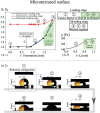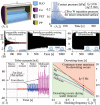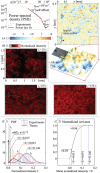Quantifying Wetting Dynamics with Triboelectrification
- PMID: 35674345
- PMCID: PMC9405515
- DOI: 10.1002/advs.202200822
Quantifying Wetting Dynamics with Triboelectrification
Abstract
Wetting is often perceived as an intrinsic surface property of materials, but determining its evolution is complicated by its complex dependence on roughness across the scales. The Wenzel (W) state, where liquids have intimate contact with the rough surfaces, and the Cassie-Baxter (CB) state, where liquids sit onto air pockets formed between asperities, are only two states among the plethora of wetting behaviors. Furthermore, transitions from the CB to the Wenzel state dictate completely different surface performance, such as anti-contamination, anti-icing, drag reduction etc.; however, little is known about how transition occurs during time between the several wetting modes. In this paper, wetting dynamics can be accurately quantified and tracked using solid-liquid triboelectrification. Theoretical underpinning reveals how surface micro-/nano-geometries regulate stability/infiltration, also demonstrating the generality of the authors' theoretical approach in understanding wetting transitions. It can clarify the functioning behavior of materials in real environment.
Keywords: TENG; Wetting dynamics; hierarchical topography; infiltration dynamics; super-hydrophobicity; theory; triboelectricity.
© 2022 The Authors. Advanced Science published by Wiley-VCH GmbH.
Conflict of interest statement
The authors declare no conflict of interest.
Figures








References
-
- Feng L., Li S., Li Y., Li H., Zhang L., Zhai J., Song Y., Liu B., Jiang L., Adv. Mater. 2002, 14, 1857.
-
- Wang D., Sun Q., Hokkanen M. J., Zhang C., Lin F. Y., Liu Q., Zhu S. P., Zhou T., Chang Q., He B., Zhou Q., Chen L., Wang Z., Ras R. H. A., Deng X., Nature 2020, 582, 55. - PubMed
-
- Liu M., Wang S., Jiang L., Nat. Rev. Mater. 2017, 2, 17036.
-
- Liu M., Jiang L., Adv. Funct. Mater. 2010, 20, 3753.
-
- Su B., Tian Y., Jiang L., J. Am. Chem. Soc. 2016, 138, 1727. - PubMed
Grants and funding
LinkOut - more resources
Full Text Sources
